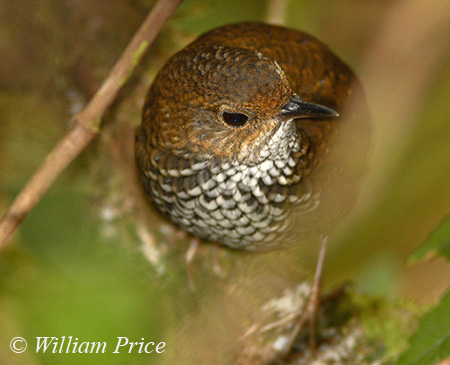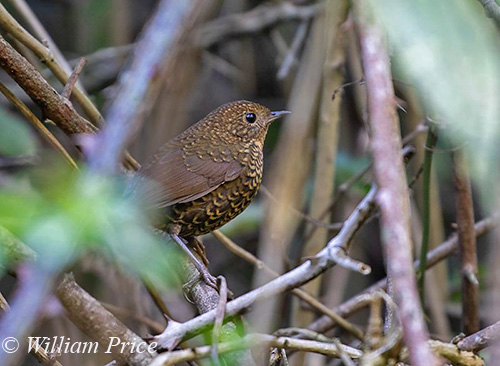
PROTECTION / THREATS / STATUS:
The Pygmy Cupwing or Pygmy Wren Babbler is described as fairly common in most parts of the range. It is the most widespread species of the small family Pnoepygidae.
The size of the population is unknown, but it is suspected to be declining, due to habitat loss, through habitat destruction and fragmentation.
However, the species is not globally threatened, and the Pygmy Cupwing or Pygmy Wren Babbler is currently evaluated as Least Concern.
Fr: Microure maillée - Turdinule maillée
Ang: Pygmy Cupwing - Pygmy Wren Babbler
All: Mooszwergpfeifer
Esp: Ratina Pigmea
Ita: Garrulo scricciolo pigmeo
Nd: Mospnoepyga
Sd: pygmékupvinge
Photographers:
John Anderson
John Anderson Photo Galleries
William Price
PBase-tereksandpiper & Flickr William Price
Dubi Shapiro
Dubi Shapiro Photo Galleries
Text by Nicole Bouglouan
Sources:
HANDBOOK OF THE BIRDS OF THE WORLD Vol 12 by Josep del Hoyo-Andrew Elliott-David Christie - Lynx Edicions - ISBN: 8496553423
A Field Guide to the Birds of South-East Asia by Craig Robson. New Holland Publishers. ISBN: 9781780090498
Fatbirder - The World’s Richest Information Resource about Birds for Birders
CREAGUS@Monterey Bay (Don Roberson)
Picture Bird
Malaysia Biodiversity Information System (MyBIS)
Wikipedia, the free encyclopaedia
Pygmy Cupwing or Pygmy Wren Babbler
Pnoepyga pusilla
Passeriformes Order – Pnoepygidae Family
INTRODUCTION:
The Pygmy Cupwing or Pygmy Wren Babbler is a very small bird, almost tailless and long-legged, with heavy scaled pattern on the brown plumage. Two morphs and seven subspecies occur.
This species is the most widespread of the genus Pnoepyga which includes four races.
The Pygmy Cupwing or Pygmy Wren Babbler is found in S and E Asia, from the Himalayas to the Lesser Sunda Islands.
It frequents the understorey of broadleaf evergreen forests close to densely vegetated ravines, mossy boulders and fallen logs. It is often observed foraging on the ground while searching for ants and other small insects, spiders, snails and grubs.
This species builds a tiny, cup-shaped nest in ferns or creepers hanging down to tree trunks or vertical rocks and other sites, up to two metres above the ground, sometimes higher. Both adults share the nesting duties. Both mates communicate by wing-flicking accompanied by soft, single calls.
The Pygmy Cupwing or Pygmy Wren Babbler is described as relatively common throughout the range, although being threatened by habitat loss. The species is not globally threatened at the moment.
DESCRIPTION OF THE BIRD:
Biometrics:
Length: 7,5 cm – 9 cm
Weight: 11-15 g
The Pygmy Cupwing or Pygmy Wren Babbler of nominate race in dark morph has olive-brown upperparts from crown to rump showing faint, dark scaling. We can see ochre subterminal spots on scapulars, wing-coverts and tertials. The flight-feathers are darker brown. The wings are cup-shaped, rounded and short.
The tail consists of six very short, brown rectrices, usually concealed by the long rump feathers.
On the underparts, breast, belly and flanks show buff-ochre scaling on the brown plumage.

On the head, the crown is olive-brown with fine, dark scaling. The ear-coverts show indistinct, pale shaft streaking. Chin and throat are ochre, with slight darker scaling.
The slender bill is blackish, slightly paler below.
The eyes are dark brown.
Legs and feet are pale, dull brown. This bird is relatively long-legged with a diminutive front claw.
Male and female are similar.
The juvenile has mainly rufous plumage, with buff-tipped greater coverts and tertials.
The Pygmy Cupwing or Pygmy Wren Babbler of nominate race in pale morph has greyish olive-brown plumage from crown to rump, with slight dark scaling. The upperwing is browner. Wing-coverts, tertials and scapulars show buffy subterminal spots. The tail is very short.
On the underparts, breast and belly are white with conspicuous scaly pattern formed by the grey-brown centres and narrow margins of the feathers. The flanks are olive-brown with buffy-olive scaling.
On the head, the sides are greyish olive-brown, whereas the ear-coverts show indistinct pale shaft streaks. Chin and throat are white with fine grey-brown scaling.
The bare parts are similar to the dark morph.
The juvenile is similar to previous.
SUBSPECIES AND RANGE:
The Pygmy Cupwing or Pygmy Wren Babbler is widely distributed across the Oriental region, from the Himalayas, S China through SE Asia into Malay Peninsula and Indonesia, as far as Flores and Timor.
It has seven recognized subspecies.
P.p. pusilla (described above) occurs in N India and Nepal, E to all NE India states, N, W, E and SE Myanmar, S and SE China, NW Thailand, N and C Laos and N Vietnam. This race also probably occurs in Hainan.
P.p. annamensis is found in SW Cambodia, S Vietnam, and possibly C Annam and S Laos.
This race has slightly darker upperparts than nominate, and blacker scaling below. The head sides are buffier.
P.p. harterti occurs in S Thailand and Peninsular Malaysia.
This one resembles previous, but the head sides are darker.
P.p. lepida is found in Sumatra.
This race is more rufescent above, whereas on the underparts, breast sides and flanks show rusty-buff edges of scaling. The sides of the head are also rusty-buff.
P.p. rufa is found in Java.
This one resembles previous, but with darker head sides and less rusty scaling on breast sides and flanks.
P.p. everetti is found in Flores where it frequents scrubs, sometimes roadside regrowth and also tall secondary forest.
This one is blackish-brown above but darker than other races. On the underparts, the extent of buff suffusion is lacking and the flanks show darker feathers centres.
P.p. timorensis is found in W Timor where it occurs around large rocky outcrops.
This race is similar to the two previous ones, but it is duller and paler. The scaly pattern is much reduced. The sides of the head are buffy-grey.
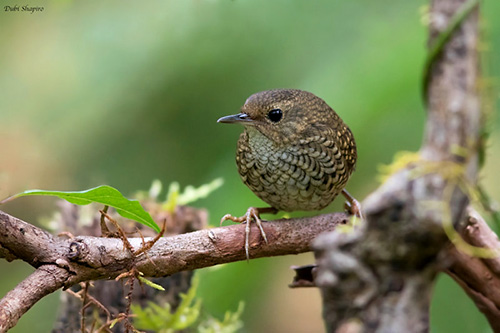
HABITAT:
The Pygmy Cupwing or Pygmy Wren Babbler is usually observed in woodlands with moderate to closed canopy. It avoids scrubland, plantations and young forest areas.
This species frequents both floor and understorey of broadleaf evergreen forests, densely vegetated ravines, dense fern growths and mossy boulders. It can also be seen along forest paths.
The bird morphology is well-adapted to luxuriant moss areas. Its preferences concerning the habitat exclude large rocky outcrops, whereas it favours the dense, humid vegetation.
This species is generally seen from 200 to 3,000 metres of elevation, depending on the range.
CALLS AND SONGS: SOUNDS BY XENO-CANTO
The Pygmy Cupwing or Pygmy Wren Babbler’s call is a repeated, sharp, loud, high-pitched “tchit”.
Both mates communicate by wing-flicking accompanied by intermittent soft, single calls every 2-3 seconds.
The race P.p. timorensis gives a curious, thin, rising whistled “tsss’u’u’u’u’u’u’u’u’u-ssi-ssi”
The song is a loud phrase of 2-3 notes, with the first one often slightly higher in pitch. It is described as a well-spaced, piercing “ti—ti—tu” repeated every 3-5 seconds.
This song may vary depending on the range.
In E Java, variations between the mountain populations are reported throughout the region.
BEHAVIOUR IN THE WILD:
The Pygmy Cupwing or Pygmy Wren Babbler forages on or near the ground in the undergrowth of wooded areas. It forages like a mouse on the floor, moving rapidly, hopping and frequently flicking the wings. It often adopts an upright posture.
It can be seen foraging on exposed roots, around rotting tree trunks, in the leaf litter and generally in the dense vegetation. It may occasionally climb up to two metres in trees, concealed among the mossy branches.
The species is insectivore, feeding on ants and other insects, but also spiders, snails and grubs.
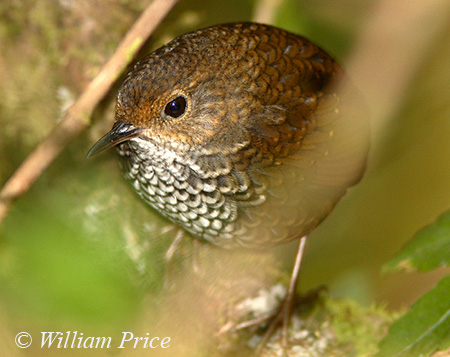
The breeding behaviour of this species is poorly known. The nest is built by both adults, a ball of moss or a tiny cup made with firmly woven green moss and lined with plant materials.
Around the nest-site and when feeding the young, both mates communicate by rapid wing-flicking, sometimes with only one wing flicked. This behaviour seems to be also used as a distraction display when intruders or potential predators approach the nest-site.
The bird flicks the wings while continuing to appear and disappear into the foliage. Some soft, single calls are given every 2-3 seconds during this behaviour. Both parents share the nesting duties.
The Pygmy Cupwing or Pygmy Wren Babbler is resident throughout most of the range. Only some local movements are reported.
The species is described as semi-terrestrial, and moves mainly by hopping. The very short, cup-shaped wings do not allow easy flight, and the flight-feathers round around the sides of the body. The bird moves mainly by hopping, darting and bounding along the ground and the mossy branches, a metre or so while searching for prey.
It moves through the dense vegetation by making short flights to reach the nest placed 0,5-2 metres above the ground.
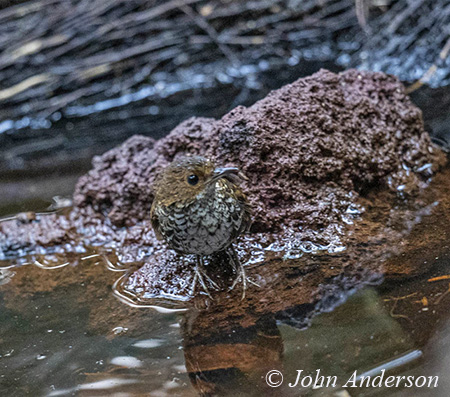
REPRODUCTION OF THIS SPECIES:
The breeding season takes place from March to September in most of the northern parts of the range. It occurs mainly in November-August in SE Asia, in July-May on Java, and November-December on Sumatra.
Both adults build the nest. It may be a small ball of moss with a side entrance, made with rootlets, bark shreds and pieces of leaves, but we can also find a built-in structure made with long strands of green moss. The inner strands are compactly and firmly woven until forming a tiny cup.
Both shapes of nests are lined with rootlets and fibres.
This structure is built in vegetation including moss, ferns or creepers hanging down tree trunks, vertical rocks or fallen logs. It may also be placed in a bank along a trail, or in upturned tree roots.
It is usually placed 0,5-2 metres above the ground, sometimes higher, up to 6 metres.
The female lays 2-6 white eggs with occasionally one or two faint spots. Both adults share the nesting duties and feed the chicks. An observation of two adults in the surroundings of their nest with prey in their bills, reports field crickets, woodlouse, larvae and other insects to feed the young.
Broken-wing display is sometimes observed when predators approach there nest-site.
